Modeling the Normalized Urban Heat Island for the City of Karlsruhe by Linking Urban Morphology and Green Infrastructure
Abstract
1. Introduction
2. Materials and Methods
2.1. Study Area in Karlsruhe, Germany—Training Data to Build the Model
2.2. Study Area in Freiburg, Germany—Test Data to Validate the Model
2.3. Processing of Normalized Observational Data from Spatial Neighborhood Analysis for Modeling
2.4. Preparation and Pre-Processing of Descriptors for Modeling and Prediction
2.5. Spatial Neighborhood Modeling with Generalized Additive Models
| Listing 1. GAMs linking normalized Ta at 2 m and PCs to describe the adjacent neighborhood. The models were trained based on mobile observations, and spatially predicted the UHI. This definition of the model represents the main idea of this study. |
 |
2.6. Model Selection
2.7. Validation and Application in Freiburg, Germany
- Mean errorThe mean error () measures the error between the modeled and the observed value [75]. The following equation was applied:with N being the number of observations, being the modeled value, and being the observed value.
- Root mean square errorThe is a measure of accuracy and gives the standard deviation of the model prediction error. This indicates how concentrated the samples are around the best-fitted curve [75]. Smaller values indicate a better model performance.The following equation was applied:with N being the number of observations, being the modeled value, and being the observed value.
- Percent biasThe average tendency of the modeled values to be larger or smaller than the measured values is given by the percent bias (). Negative values indicate an underestimation bias, positive values indicate an overestimation bias [75]. The bias is expressed in percentage and calculated using the following formula:with N being the number of observations, being the modeled value, and being the observed value.
3. Results
3.1. Spatial Prediction of the Urban Heat Island on the Normalized Scale
3.2. Validation and Error of the Model Output
4. Discussion
4.1. Missing Coverage of Specific Land Cover
4.2. Missing Data on Anthropogenic Heat Production and Soil Moisture
4.3. Concurvity Shows the Dependency of Various Predictors
4.4. Applications and Implications of Spatial UHI Modeling in Resilient Urban Planning, Health Sector, Tourism, and Architecture
5. Conclusions
Author Contributions
Funding
Institutional Review Board Statement
Informed Consent Statement
Data Availability Statement
Acknowledgments
Conflicts of Interest
Appendix A. Additional Results of the F-Statistic of the Trained Models
| Smooth-Term | k-Index | p-Value | |
|---|---|---|---|
| s(PC1) | 0.80 | 189.7 | |
| s(PC2) | 0.76 | 2.0 | 0.0877 |
| s(PC3) | 0.79 | 18.0 | |
| s(PC4) | 0.78 | 2.0 | 0.0815 |
| s(PC5) | 0.81 | 20.1 |
| Smooth-Term | k-Index | p-Value | |
|---|---|---|---|
| s(PC1) | 0.74 | 58.2 | |
| s(PC2) | 0.76 | 7.1 | 0.0043 |
| s(PC3) | 0.83 | 3.2 | 0.0358 |
| s(PC4) | 0.79 | 5.9 | 0.0078 |
| s(PC5) | 0.77 | 31.3 |
| Smooth-Term | k-Index | p-Value | |
|---|---|---|---|
| s(PC1) | 0.80 | 11.6 | 0.0070 |
| s(PC2) | 0.82 | 11.6 | 0.0003 |
| s(PC3) | 0.81 | 0.1 | 0.2752 |
| s(PC4) | 0.77 | 0.0 | 0.3753 |
| s(PC5) | 0.80 | 6.1 | 0.0066 |
| Smooth-Term | k-Index | p-Value | |
|---|---|---|---|
| s(PC1) | 0.80 | 215.0 | |
| s(PC2) | 0.70 | 0.0 | 0.6450 |
| s(PC3) | 0.77 | 0.0 | 0.6610 |
| s(PC4) | 0.75 | 0.0 | 0.3590 |
| s(PC5) | 0.77 | 23.5 |
Appendix B. Spatial Prediction of the UHI Pattern in Karlsruhe for Different Time Intervals
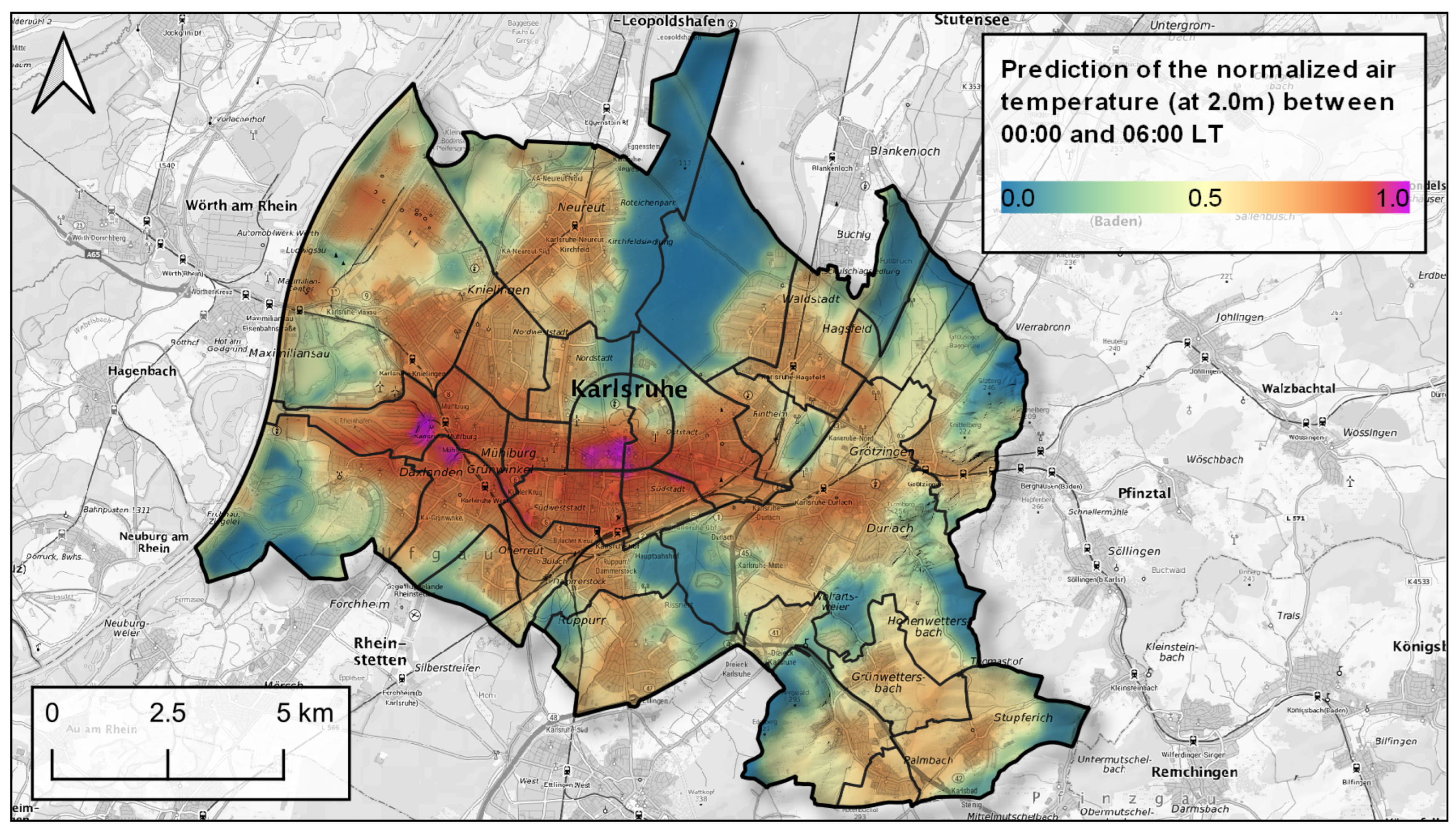
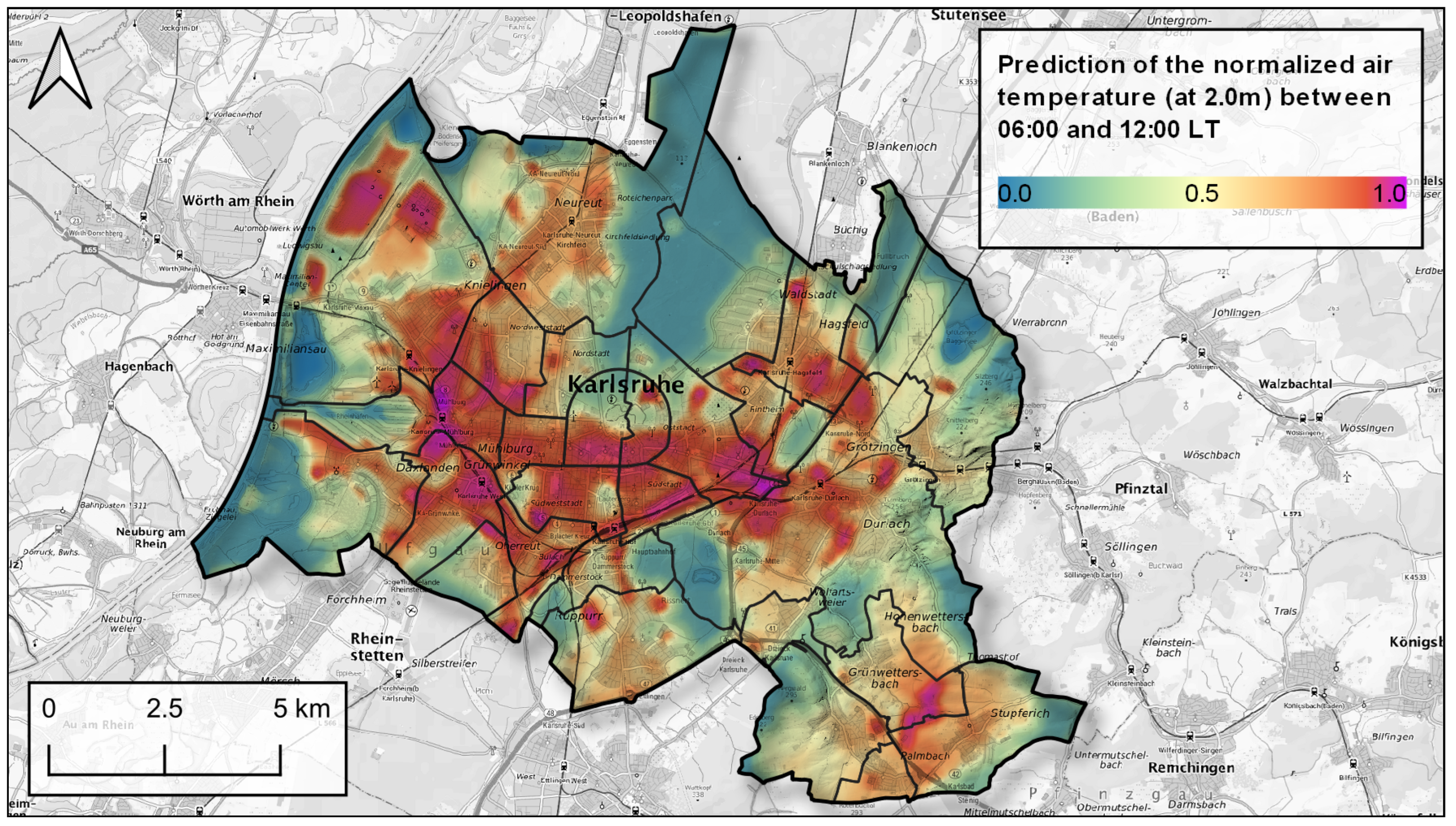
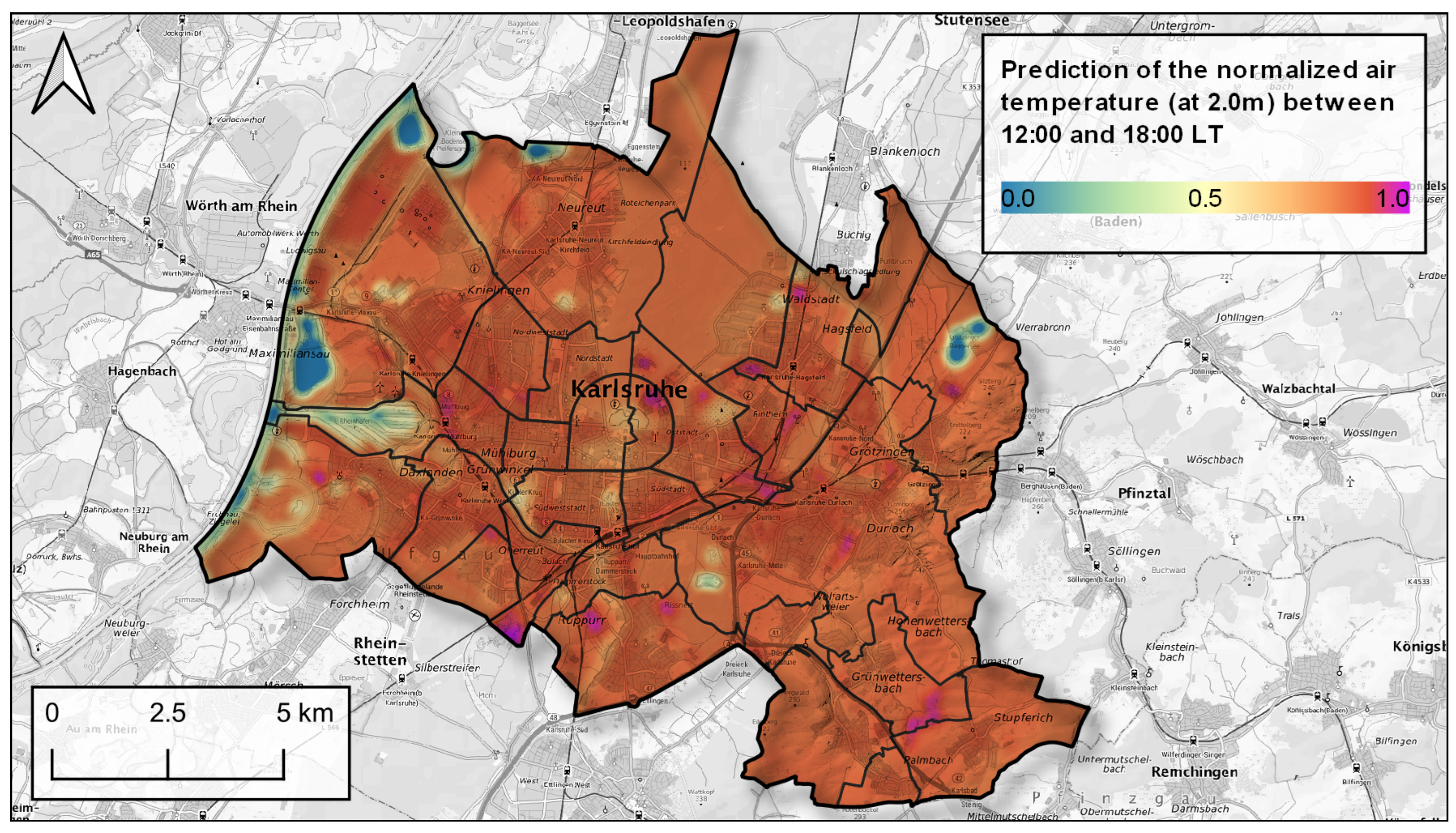
Appendix C. Mean Intensity of the S-UHI Pattern Based on LST in Karlsruhe

Appendix D. Spatial Prediction of the UHI Pattern in Freiburg for Different Time Intervals

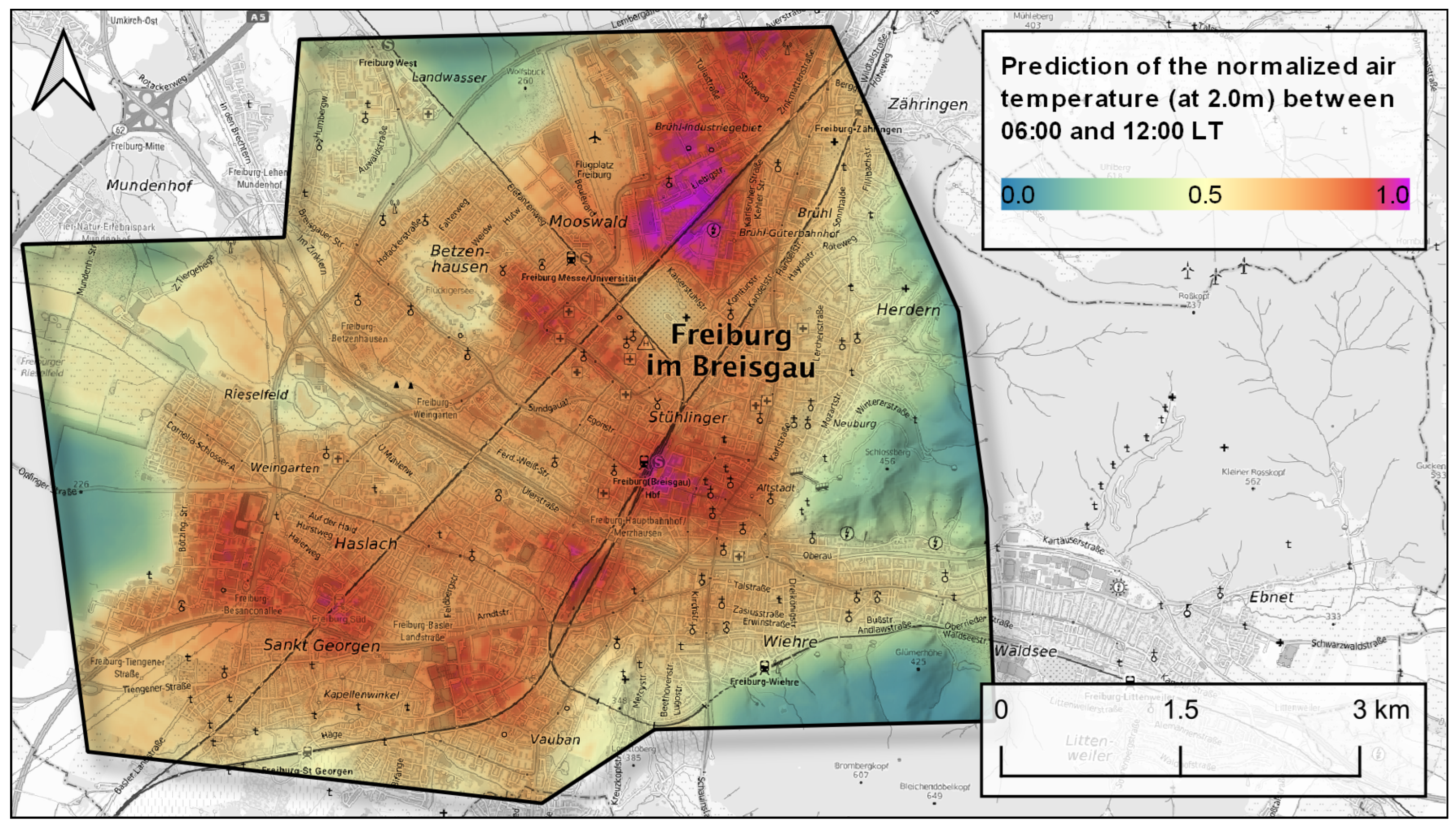
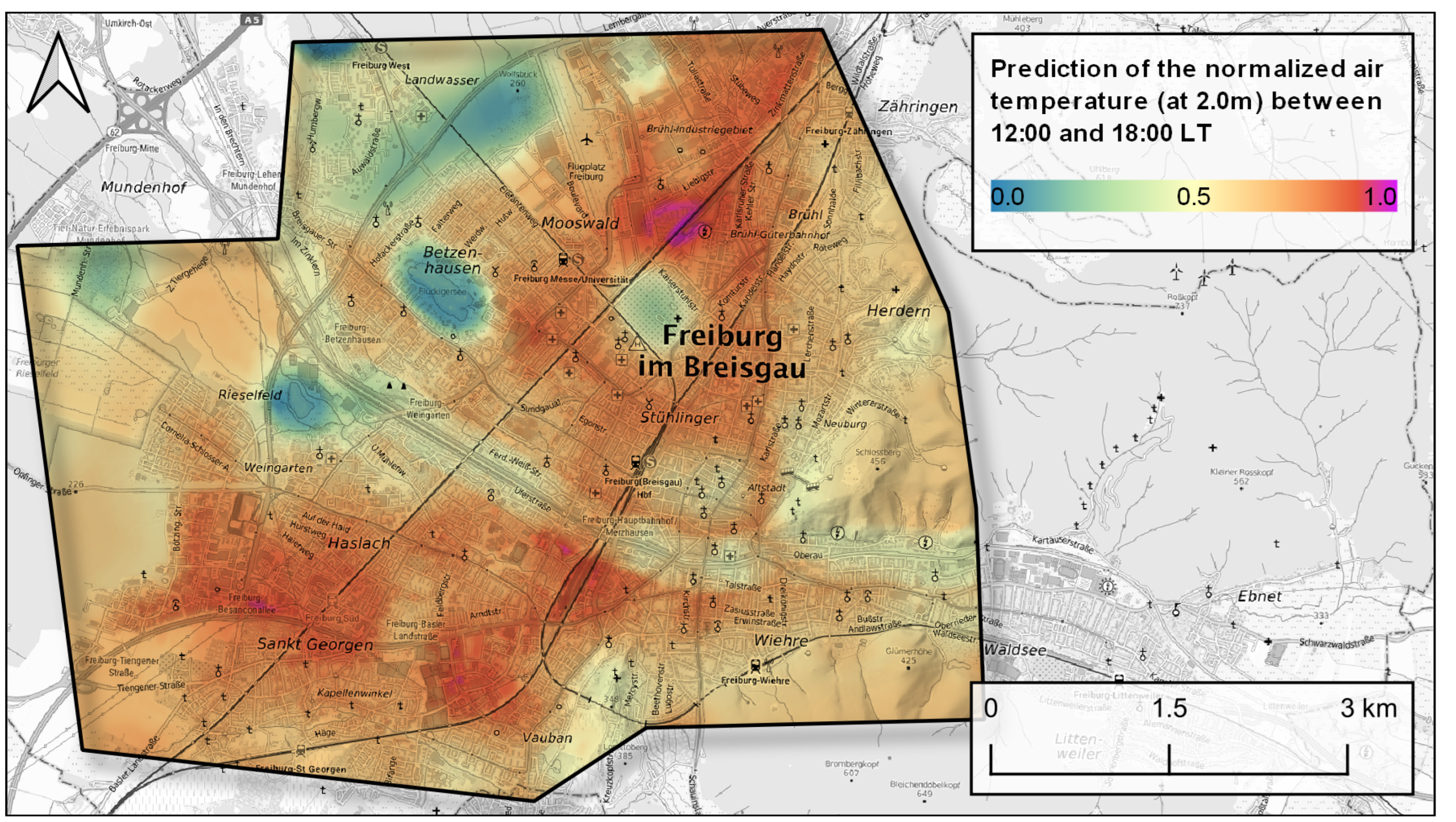
References
- United Nations, Department of Economic and Social Affairs, Population Division. World Urbanization Prospects: The 2018 Revision; United Nations, Department of Economic and Social Affairs, Population Division: New York, NY, USA, 2019. [Google Scholar]
- Gehl, J. Cities for People; Island Press: Washington, DC, USA, 2010. [Google Scholar]
- Węziak-Białowolska, D. Quality of life in cities—Empirical evidence in comparative European perspective. Cities 2016, 58, 87–96. [Google Scholar] [CrossRef]
- Matzarakis, A. A Note on the Assessment of the Effect of Atmospheric Factors and Components on Humans. Atmosphere 2020, 11, 1283. [Google Scholar] [CrossRef]
- Revi, A.; Satterthwaite, D.E.; Aragón-Durand, F.; Corfee-Morlot, J.; Kiunsi, R.B.R.; Pelling, M.; Roberts, D.C.; Solecki, W. Urban areas. In Climate Change 2014: Impacts, Adaptation, and Vulnerability. Part A: Global and Sectoral Aspects. Contribution of Working Group II to the Fifth Assessment Report of the Intergovernmental Panel of Climate Change; Field, C.B., Barros, V.R., Dokken, D.J., Mach, K.J., Mastrandrea, M.D., Bilir, T.E., Chatterjee, M., Ebi, K.L., Estrada, Y.O., Genova, R.C., et al., Eds.; Cambridge University Press: Cambridge, UK; New York, NY, USA, 2014; pp. 535–612. [Google Scholar]
- Masson, V.; Lemonsu, A.; Hidalgo, J.; Voogt, J. Urban Climates and Climate Change. Annu. Rev. Environ. Resour. 2020, 45, 411–444. [Google Scholar] [CrossRef]
- Zeeshan, M.; Ali, Z. The Potential of Cool Materials Towards Improving Thermal Comfort Conditions Inside Real-urban Hot-humid Microclimate. Environ. Urban. Asia 2022, 13, 56–72. [Google Scholar] [CrossRef]
- Šenfeldr, M.; Maděra, P.; Kotásková, P.; Fialová, J.; Kundrata, M.; Rieger, V. The Green Roofs and Facades as a Tool of Climate Cooling in the Urban Environment. In Management of Water Quality and Quantity; Zelenakova, M., Hlavínek, P., Negm, A.M., Eds.; Springer International Publishing: Cham, Switzerland, 2020; pp. 39–75. [Google Scholar] [CrossRef]
- Akbari, H.; Pomerantz, M.; Taha, H. Cool surfaces and shade trees to reduce energy use and improve air quality in urban areas. Sol. Energy 2001, 70, 295–310. [Google Scholar] [CrossRef]
- Eingrüber, N.; Domm, A.; Korres, W.; Löhnert, U.; Schneider, K. Climate change adaption potentials of unsealing strategies in cities – An assessment during heat and drought events based on microclimatic simulations. In Proceedings of the EMS Anual Meeting 2023, Bratislava, Slovakia, 3–8 September 2023. [Google Scholar] [CrossRef]
- Wang, L.; Huang, M.; Li, D. Where Are White Roofs More Effective in Cooling the Surface? Geophys. Res. Lett. 2020, 47, e2020GL087853. [Google Scholar] [CrossRef]
- Masson, V.; Heldens, W.; Bocher, E.; Bonhomme, M.; Bucher, B.; Burmeister, C.; de Munck, C.; Esch, T.; Hidalgo, J.; Kanani-Sühring, F.; et al. City-descriptive input data for urban climate models: Model requirements, data sources and challenges. Urban Clim. 2020, 31, 100536. [Google Scholar] [CrossRef]
- Sobrino, J.; Oltra-Carrió, R.; Sòria, G.; Bianchi, R.; Paganini, M. Impact of spatial resolution and satellite overpass time on evaluation of the surface urban heat island effects. Remote. Sens. Environ. 2012, 117, 50–56. [Google Scholar] [CrossRef]
- Voogt, J.A.; Oke, T.R. Effects of urban surface geometry on remotely-sensed surface temperature. Int. J. Remote Sens. 1998, 19, 895–920. [Google Scholar] [CrossRef]
- Wang, D.; Chen, Y.; Hu, L.; Voogt, J.A.; He, X. Satellite-based daytime urban thermal anisotropy: A comparison of 25 global cities. Remote. Sens. Environ. 2022, 283, 113312. [Google Scholar] [CrossRef]
- Parsons, K.C. Human Thermal Environments: The Effects of Hot, Moderate, and Cold Environments on Human Health, Comfort, and Performance, 3rd ed.; CRC Press/Taylor & Francis: Boca Raton, FL, USA, 2014. [Google Scholar]
- Voogt, J.; Oke, T. Thermal remote sensing of urban climates. Remote Sens. Environ. 2003, 86, 370–384. [Google Scholar] [CrossRef]
- Gallo, K.; Hale, R.; Tarpley, D.; Yu, Y. Evaluation of the Relationship between Air and Land Surface Temperature under Clear- and Cloudy-Sky Conditions. J. Appl. Meteorol. Climatol. 2011, 50, 767–775. [Google Scholar] [CrossRef]
- Pichierri, M.; Bonafoni, S.; Biondi, R. Satellite air temperature estimation for monitoring the canopy layer heat island of Milan. Remote Sens. Environ. 2012, 127, 130–138. [Google Scholar] [CrossRef]
- Huang, W.; Li, J.; Guo, Q.; Mansaray, L.; Li, X.; Huang, J. A Satellite-Derived Climatological Analysis of Urban Heat Island over Shanghai during 2000–2013. Remote Sens. 2017, 9, 641. [Google Scholar] [CrossRef]
- Romero Rodríguez, L.; Sánchez Ramos, J.; Sánchez de la Flor, F.J.; Álvarez Domínguez, S. Analyzing the urban heat Island: Comprehensive methodology for data gathering and optimal design of mobile transects. Sustain. Cities Soc. 2020, 55, 102027. [Google Scholar] [CrossRef]
- Kotharkar, R.; Surawar, M. Land Use, Land Cover, and Population Density Impact on the Formation of Canopy Urban Heat Islands through Traverse Survey in the Nagpur Urban Area, India. J. Urban Plan. Dev. 2016, 142, 04015003. [Google Scholar] [CrossRef]
- Saaroni, H.; Ben-Dor, E.; Bitan, A.; Potchter, O. Spatial distribution and microscale characteristics of the urban heat island in Tel-Aviv, Israel. Landsc. Urban Plan. 2000, 48, 1–18. [Google Scholar] [CrossRef]
- Chandler, T.J. Temperature and Humidity Traverses across London. Weather 1962, 17, 235–242. [Google Scholar] [CrossRef]
- Straub, A.; Berger, K.; Breitner, S.; Cyrys, J.; Geruschkat, U.; Jacobeit, J.; Kühlbach, B.; Kusch, T.; Philipp, A.; Schneider, A.; et al. Statistical modelling of spatial patterns of the urban heat island intensity in the urban environment of Augsburg, Germany. Urban Clim. 2019, 29, 100491. [Google Scholar] [CrossRef]
- Shandas, V.; Voelkel, J.; Williams, J.; Hoffman, J. Integrating Satellite and Ground Measurements for Predicting Locations of Extreme Urban Heat. Climate 2019, 7, 5. [Google Scholar] [CrossRef]
- Voelkel, J.; Shandas, V. Towards Systematic Prediction of Urban Heat Islands: Grounding Measurements, Assessing Modeling Techniques. Climate 2017, 5, 41. [Google Scholar] [CrossRef]
- Zumwald, M.; Knüsel, B.; Bresch, D.N.; Knutti, R. Mapping urban temperature using crowd-sensing data and machine learning. Urban Clim. 2021, 35, 100739. [Google Scholar] [CrossRef]
- Zumwald, M.; Baumberger, C.; Bresch, D.N.; Knutti, R. Assessing the representational accuracy of data-driven models: The case of the effect of urban green infrastructure on temperature. Environ. Model. Softw. 2021, 141, 105048. [Google Scholar] [CrossRef]
- Chen, S.; Yang, Y.; Deng, F.; Zhang, Y.; Liu, D.; Liu, C.; Gao, Z. A high-resolution monitoring approach of canopy urban heat island using a random forest model and multi-platform observations. Atmos. Meas. Tech. 2022, 15, 735–756. [Google Scholar] [CrossRef]
- Venter, Z.S.; Brousse, O.; Esau, I.; Meier, F. Hyperlocal mapping of urban air temperature using remote sensing and crowdsourced weather data. Remote Sens. Environ. 2020, 242, 111791. [Google Scholar] [CrossRef]
- Venter, Z.S.; Chakraborty, T.; Lee, X. Crowdsourced air temperatures contrast satellite measures of the urban heat island and its mechanisms. Sci. Adv. 2021, 7, eabb9569. [Google Scholar] [CrossRef] [PubMed]
- Vulova, S.; Meier, F.; Fenner, D.; Nouri, H.; Kleinschmit, B. Summer Nights in Berlin, Germany: Modeling Air Temperature Spatially With Remote Sensing, Crowdsourced Weather Data, and Machine Learning. IEEE J. Sel. Top. Appl. Earth Obs. Remote Sens. 2020, 13, 5074–5087. [Google Scholar] [CrossRef]
- Dos Santos, R.S. Estimating spatio-temporal air temperature in London (UK) using machine learning and earth observation satellite data. Int. J. Appl. Earth Obs. Geoinf. 2020, 88, 102066. [Google Scholar] [CrossRef]
- Fiorillo, E.; Brilli, L.; Carotenuto, F.; Cremonini, L.; Gioli, B.; Giordano, T.; Nardino, M. Diurnal Outdoor Thermal Comfort Mapping through Envi-Met Simulations, Remotely Sensed and In Situ Measurements. Atmosphere 2023, 14, 641. [Google Scholar] [CrossRef]
- Nardino, M.; Cremonini, L.; Crisci, A.; Georgiadis, T.; Guerri, G.; Morabito, M.; Fiorillo, E. Mapping daytime thermal patterns of Bologna municipality (Italy) during a heatwave: A new methodology for cities adaptation to global climate change. Urban Clim. 2022, 46, 101317. [Google Scholar] [CrossRef]
- D’Acci, L. (Ed.) The Mathematics of Urban Morphology; Modeling and Simulation in Science, Engineering and Technology Series; Springer International Publishing: Cham, Switzerland, 2019. [Google Scholar] [CrossRef]
- European Environment Agency (EEA). Copernicus Land Monitoring Service 2018; European Environment Agency: Copenhagen, Denmark, 2018.
- Stewart, I.D.; Oke, T.R. Local Climate Zones for Urban Temperature Studies. Bull. Am. Meteorol. Soc. 2012, 93, 1879–1900. [Google Scholar] [CrossRef]
- Oke, T.R. Initial Guidance to Obtain Representative Meteorological Observations at Urban Sites; World Meteorological Organization: Geneva, Switzerland, 2004. [Google Scholar]
- Keil, M.; Kiefl, R.; Strunz, G. CORINE Land Cover 2000—European-Wide Harmonised Update of Land Use Data for Germany; DLR: Wessling, Germany, 2005. [Google Scholar]
- Oke, T.R.; Mills, G.; Christen, A.; Voogt, J.A. Urban Climates; Cambridge University Press: Cambridge, UK, 2017. [Google Scholar] [CrossRef]
- ASHRAE. 2017 ASHRAE Handbook: Fundamentals; ASHRAE: Peachtree Corners, GA, USA, 2017. [Google Scholar]
- Jones, H.G. Plants and Microclimate: A Quantitative Approach to Environmental Plant Physiology, 3rd ed.; Cambridge University Press: Cambridge, UK, 2013. [Google Scholar] [CrossRef]
- Ferrini, F.; van den Bosch, C.; Fini, A. (Eds.) Routledge Handbook of Urban Forestry; Routledge/Taylor & Francis: London, UK; New York, NY, USA, 2017. [Google Scholar]
- Solcerova, A.; van de Ven, F.; van de Giesen, N. Nighttime Cooling of an Urban Pond. Front. Earth Sci. 2019, 7, 156. [Google Scholar] [CrossRef]
- Toparlar, Y.; Blocken, B.; Maiheu, B.; van Heijst, G. A review on the CFD analysis of urban microclimate. Renew. Sustain. Energy Rev. 2017, 80, 1613–1640. [Google Scholar] [CrossRef]
- Antoniou, N.; Montazeri, H.; Neophytou, M.; Blocken, B. CFD simulation of urban microclimate: Validation using high-resolution field measurements. Sci. Total Environ. 2019, 695, 133743. [Google Scholar] [CrossRef] [PubMed]
- Buccolieri, R.; Hang, J. Recent Advances in Urban Ventilation Assessment and Flow Modelling. Atmosphere 2019, 10, 144. [Google Scholar] [CrossRef]
- Kang, G.; Kim, J.J.; Choi, W. Computational fluid dynamics simulation of tree effects on pedestrian wind comfort in an urban area. Sustain. Cities Soc. 2020, 56, 102086. [Google Scholar] [CrossRef]
- Lenz, S.; Schönherr, M.; Geier, M.; Krafczyk, M.; Pasquali, A.; Christen, A.; Giometto, M. Towards real-time simulation of turbulent air flow over a resolved urban canopy using the cumulant lattice Boltzmann method on a GPGPU. J. Wind Eng. Ind. Aerodyn. 2019, 189, 151–162. [Google Scholar] [CrossRef]
- Mortezazadeh, M.; Wang, L.L.; Albettar, M.; Yang, S. CityFFD – City fast fluid dynamics for urban microclimate simulations on graphics processing units. Urban Clim. 2022, 41, 101063. [Google Scholar] [CrossRef]
- Mortezazadeh, M.; Zou, J.; Hosseini, M.; Yang, S.; Wang, L. Estimating Urban Wind Speeds and Wind Power Potentials Based on Machine Learning with City Fast Fluid Dynamics Training Data. Atmosphere 2022, 13, 214. [Google Scholar] [CrossRef]
- Gangwisch, M.; Saha, S.; Matzarakis, A. Spatial neighborhood analysis linking urban morphology and green infrastructure to atmospheric conditions in Karlsruhe, Germany. Urban Clim. 2023, 51, 101624. [Google Scholar] [CrossRef]
- Hastie, T.; Tibshirani, R. Generalized additive models. In Generalized Additive Models, 1st ed.; Routledge: Abingdon-on-Thames, UK, 2017; pp. 136–173. [Google Scholar] [CrossRef]
- Ravindra, K.; Rattan, P.; Mor, S.; Aggarwal, A.N. Generalized additive models: Building evidence of air pollution, climate change and human health. Environ. Int. 2019, 132, 104987. [Google Scholar] [CrossRef] [PubMed]
- Bassett, R.; Janes-Bassett, V.; Phillipson, J.; Young, P.; Blair, G. Climate driven trends in London’s urban heat island intensity reconstructed over 70 years using a generalized additive model. Urban Clim. 2021, 40, 100990. [Google Scholar] [CrossRef]
- Wagner, A. Zukünftige Klimaentwicklungen in Baden-Württemberg: Perspektiven aus Regionalen Klimamodellen, langfassung ed.; Landesanstalt für Umwelt, Messungen und Naturschutz Baden-Württemberg: Karlsruhe, Germany, 2013. [Google Scholar]
- Gebhardt, H.; Landesanstalt für Umwelt, Messungen und Naturschutz Baden-Württemberg (Eds.) Climate Change in Baden-Württemberg: Facts-Impacts-Perspectives, 2nd updated ed.; Ministry of the Environment, Climate Protection and the Energy Sector: Stuttgart, Germany, 2012. [Google Scholar]
- Hackenbruch, J. Anpassungsrelevante Klimaänderungen für Städtische Baustrukturen und Wohnquartiere; Number 77 in Wissenschaftliche Berichte des Instituts für Meteorologie und Klimaforschung des Karlsruher Instituts für Technologie; KIT Scientific Publishing: Karlsruhe, Germany, 2018. [Google Scholar]
- Rubel, F.; Kottek, M. Observed and projected climate shifts 1901-2100 depicted by world maps of the Köppen-Geiger climate classification. Meteorol. Z. 2010, 19, 135–141. [Google Scholar] [CrossRef]
- Statistisches Landesamt Baden-Württemberg. Bevölkerung, Gebiet und Bevölkerungsdichte. 2020. Available online: https://www.statistik-bw.de/BevoelkGebiet/Bevoelkerung/01515020.tab?R=KR212 (accessed on 18 November 2021).
- Pfeifer, S.; Bathiany, S.; Rechid, D. Klimaausblick Karlsruhe und Angrenzende Landkreise; Climate Service Center Germany (GERICS), Helmholtz-Zentrum Hereon GmbH: Hamburg, Germany, 2021. [Google Scholar]
- Statistisches Landesamt Baden-Württemberg. Statistische Berichte Baden-Württemberg; Statistisches Landesamt Baden-Württemberg: Stuttgart, Germany, 2021. [Google Scholar]
- Deutscher Wetterdienst. Niederschlag: Vieljährige Mittelwerte 1981–2010; Deutscher Wetterdienst: Offenbach am Main, Germany, 2023. [Google Scholar]
- Deutscher Wetterdienst. Temperatur: Vieljährige Mittelwerte 1981–2010; Deutscher Wetterdienst: Offenbach am Main, Germany, 2023. [Google Scholar]
- Matzarakis, A.; Röckle, R.; Richter, C.J.; Höfl, H.C.; Steinicke, W.; Streifeneder, M.; Mayer, H. Planungsrelevante Bewertung des Stadtklimas - am Beispiel von Freiburg im Breisgau. Gefahrstoffe Reinhalt. Der Luft 2008, 68, 334–340. [Google Scholar]
- Pfeifer, S.; Bathiany, S.; Rechid, D. Klimaausblick Freiburg im Breisgau und Angrenzende Landkreise; Climate Service Center Germany (GERICS), Helmholtz-Zentrum Hereon GmbH: Hamburg, Germany, 2021. [Google Scholar]
- Christen, A. Meteobike—Mapping Urban Heat Islands with Bikes. 2023. Available online: https://github.com/achristen/Meteobike (accessed on 28 June 2023).
- Conrad, O.; Bechtel, B.; Bock, M.; Dietrich, H.; Fischer, E.; Gerlitz, L.; Wehberg, J.; Wichmann, V.; Böhner, J. System for Automated Geoscientific Analyses (SAGA) v. 2.1.4. Geosci. Model Dev. 2015, 8, 1991–2007. [Google Scholar] [CrossRef]
- Open Source Geospatial Foundation. QGIS Geographic Information System; Open Source Geospatial Foundation: Beaverton, OR, USA, 2023. [Google Scholar]
- Ermida, S.L.; Soares, P.; Mantas, V.; Göttsche, F.M.; Trigo, I.F. Google Earth Engine Open-Source Code for Land Surface Temperature Estimation from the Landsat Series. Remote Sens. 2020, 12, 1471. [Google Scholar] [CrossRef]
- OpenStreetMap Contributors. Planet Dump. 2021. Available online: https://planet.osm.org (accessed on 17 May 2021).
- Wood, S.N. Generalized Additive Models: An Introduction with R, 2nd ed.; Chapman and Hall/CRC: Boca Raton, FL, USA, 2017. [Google Scholar] [CrossRef]
- Zambrano-Bigiarini, M. hydroGOF: Goodness-of-fit Functions for Comparison of Simulated and Observed Hydrological Time Series. Available online: https://zenodo.org/records/3707013 (accessed on 24 May 2023).
- Nosratabadi, S.; Mosavi, A.; Keivani, R.; Ardabili, S.; Aram, F. State of the Art Survey of Deep Learning and Machine Learning Models for Smart Cities and Urban Sustainability. In Engineering for Sustainable Future; Várkonyi-Kóczy, A.R., Ed.; Springer International Publishing: Cham, Switzerland, 2020; Volume 101, pp. 228–238. [Google Scholar] [CrossRef]
- Höppe, P. The physiological equivalent temperature—A universal index for the biometeorological assessment of the thermal environment. Int. J. Biometeorol. 1999, 43, 71–75. [Google Scholar] [CrossRef]
- Mayer, H.; Höppe, P. Thermal comfort of man in different urban environments. Theor. Appl. Climatol. 1987, 38, 43–49. [Google Scholar] [CrossRef]
- Miller, S.J.; Gordon, M. The measurement of mean wind, variances, and covariances from an instrumented mobile car in a rural environment. Atmos. Meas. Tech. 2022, 15, 6563–6584. [Google Scholar] [CrossRef]
- Gangwisch, M.; Fröhlich, D.; Christen, A.; Matzarakis, A. Geometrical Assessment of Sunlit and Shaded Area of Urban Trees Based on Aligned Orthographic Views. Atmosphere 2021, 12, 968. [Google Scholar] [CrossRef]
- Monteith, J.L.; Unsworth, M.H. Principles of Environmental Physics: Plants, Animals, and the Atmosphere, 4th ed.; Elsevier: Amsterdam, The Netherlands, 2014. [Google Scholar]
- Matzarakis, A.; Gangwisch, M.; Fröhlich, D. RayMan and SkyHelios Model. In Urban Microclimate Modelling for Comfort and Energy Studies; Palme, M., Salvati, A., Eds.; Springer International Publishing: Cham, Switzerland, 2021; pp. 339–361. [Google Scholar] [CrossRef]
- Briegel, F.; Makansi, O.; Brox, T.; Matzarakis, A.; Christen, A. Modelling long-term thermal comfort conditions in urban environments using a deep convolutional encoder-decoder as a computational shortcut. Urban Clim. 2023, 47, 101359. [Google Scholar] [CrossRef]
- Schrotter, G.; Hürzeler, C. The Digital Twin of the City of Zurich for Urban Planning. PFG J. Photogramm. Remote Sens. Geoinf. Sci. 2020, 88, 99–112. [Google Scholar] [CrossRef]
- Guo, Y.; Zhang, H.; Li, Q.; Lin, Y.; Michalski, J. New morphological features for urban tree species identification using LiDAR point clouds. Urban For. Urban Green. 2022, 71, 127558. [Google Scholar] [CrossRef]
- Wang, R.; Peethambaran, J.; Chen, D. LiDAR Point Clouds to 3-D Urban Models: A Review. IEEE J. Sel. Top. Appl. Earth Obs. Remote Sens. 2018, 11, 606–627. [Google Scholar] [CrossRef]
- Ketterer, C.; Matzarakis, A. Human-biometeorological assessment of the urban heat island in a city with complex topography—The case of Stuttgart, Germany. Urban Clim. 2014, 10, 573–584. [Google Scholar] [CrossRef]
- Ketterer, C.; Matzarakis, A. Comparison of different methods for the assessment of the urban heat island in Stuttgart, Germany. Int. J. Biometeorol. 2015, 59, 1299–1309. [Google Scholar] [CrossRef] [PubMed]
- Theeuwes, N.E.; Solcerová, A.; Steeneveld, G.J. Modeling the influence of open water surfaces on the summertime temperature and thermal comfort in the city. J. Geophys. Res. Atmos. 2013, 118, 8881–8896. [Google Scholar] [CrossRef]
- Aksoy, T.; Dabanli, A.; Cetin, M.; Senyel Kurkcuoglu, M.A.; Cengiz, A.E.; Cabuk, S.N.; Agacsapan, B.; Cabuk, A. Evaluation of comparing urban area land use change with Urban Atlas and CORINE data. Environ. Sci. Pollut. Res. 2022, 29, 28995–29015. [Google Scholar] [CrossRef]
- Varquez, A.C.G.; Kiyomoto, S.; Khanh, D.N.; Kanda, M. Global 1-km present and future hourly anthropogenic heat flux. Sci. Data 2021, 8, 64. [Google Scholar] [CrossRef]
- Google. Google Environment Insights Explorer. 2023. Available online: https://insights.sustainability.google/ (accessed on 28 June 2023).
- World Health Organization. Urban Green Spaces: A Brief for Action; World Health Organization: Copenhagen, Denmark, 2017. [Google Scholar]
- Flouris, A.D.; Dinas, P.C.; Ioannou, L.G.; Nybo, L.; Havenith, G.; Kenny, G.P.; Kjellstrom, T. Workers’ health and productivity under occupational heat strain: A systematic review and meta-analysis. Lancet Planet. Health 2018, 2, e521–e531. [Google Scholar] [CrossRef]
- Beckmann-Wübbelt, A.; Fricke, A.; Sebesvari, Z.; Yakouchenkova, I.A.; Fröhlich, K.; Saha, S. High public appreciation for the cultural ecosystem services of urban and peri-urban forests during the COVID-19 pandemic. Sustain. Cities Soc. 2021, 74, 103240. [Google Scholar] [CrossRef]
- Alsaad, H.; Hartmann, M.; Hilbel, R.; Voelker, C. The potential of facade greening in mitigating the effects of heatwaves in Central European cities. Build. Environ. 2022, 216, 109021. [Google Scholar] [CrossRef]
- Peng, L.L.; Jiang, Z.; Yang, X.; He, Y.; Xu, T.; Chen, S.S. Cooling effects of block-scale facade greening and their relationship with urban form. Build. Environ. 2020, 169, 106552. [Google Scholar] [CrossRef]
- Abass, F.; Ismail, L.H.; Wahab, I.A.; Elgadi, A.A. A Review of Green Roof: Definition, History, Evolution and Functions. IOP Conf. Ser. Mater. Sci. Eng. 2020, 713, 012048. [Google Scholar] [CrossRef]
- Bowler, D.E.; Buyung-Ali, L.; Knight, T.M.; Pullin, A.S. Urban greening to cool towns and cities: A systematic review of the empirical evidence. Landsc. Urban Plan. 2010, 97, 147–155. [Google Scholar] [CrossRef]
- Wüstemann, H.; Kolbe, J. Der Einfluss städtischer Grünflächen auf die Immobilienpreise: Eine hedonische Analyse für die Stadt Berlin. Raumforsch. Und Raumordn. Spat. Res. Plan. 2017, 75, 429–438. [Google Scholar] [CrossRef][Green Version]
- Astell-Burt, T.; Feng, X.; Mavoa, S.; Badland, H.M.; Giles-Corti, B. Do low-income neighbourhoods have the least green space? A cross-sectional study of Australia’s most populous cities. BMC Public Health 2014, 14, 292. [Google Scholar] [CrossRef]
- United Nations. Sendai framework for disaster risk reduction 2015–2030. In Proceedings of the Third United Nations World Conference on Disaster Risk Reduction (WCDRR)—Resilient People, Resilient Planet, Sendai, Japan, 14–18 March 2015. [Google Scholar]
- United Nations. Transforming Our World: The 2030 Agenda for Sustainable Development—A/RES/70/1; United Nations: New York, NY, USA, 2015. [Google Scholar]
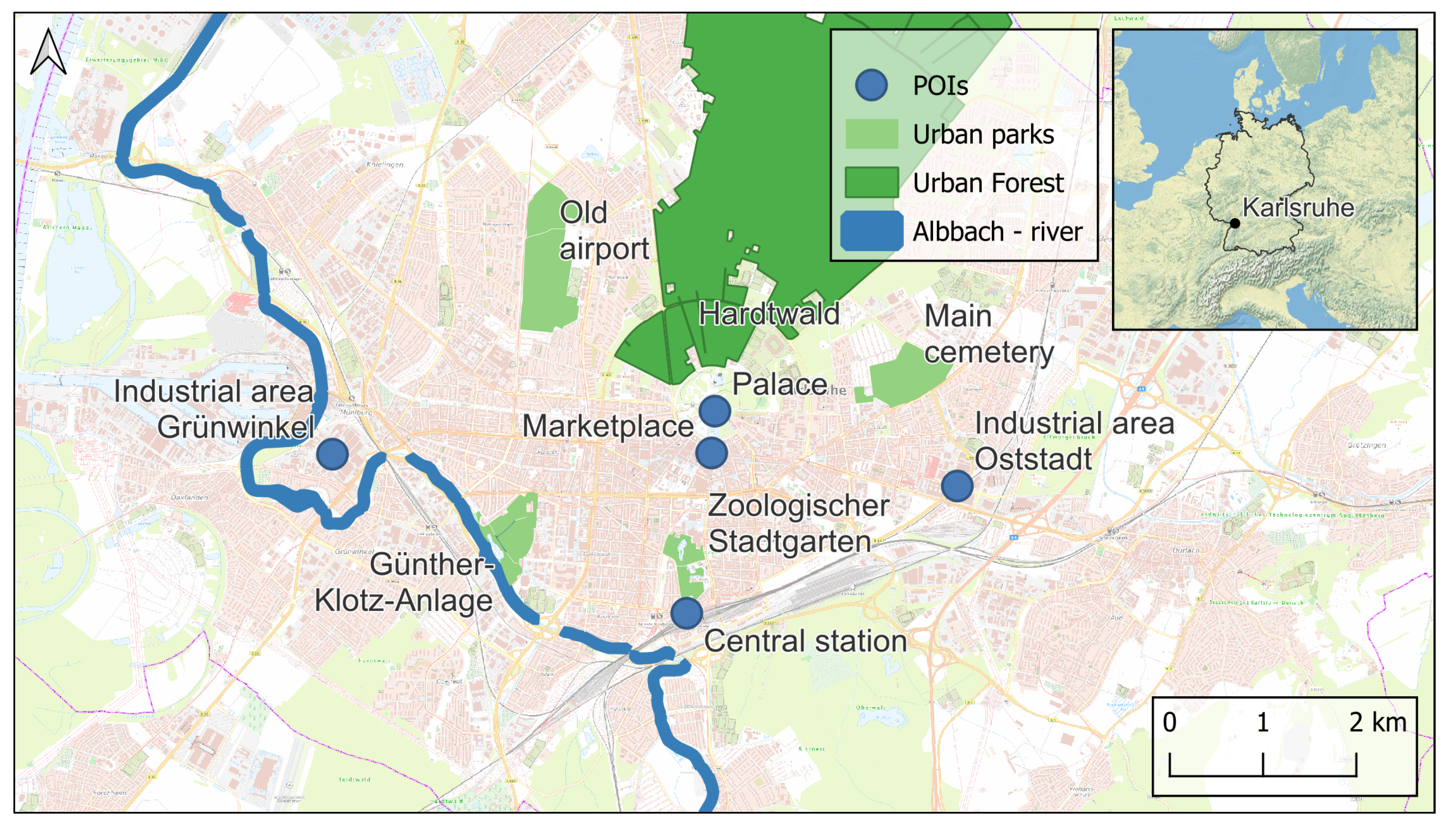
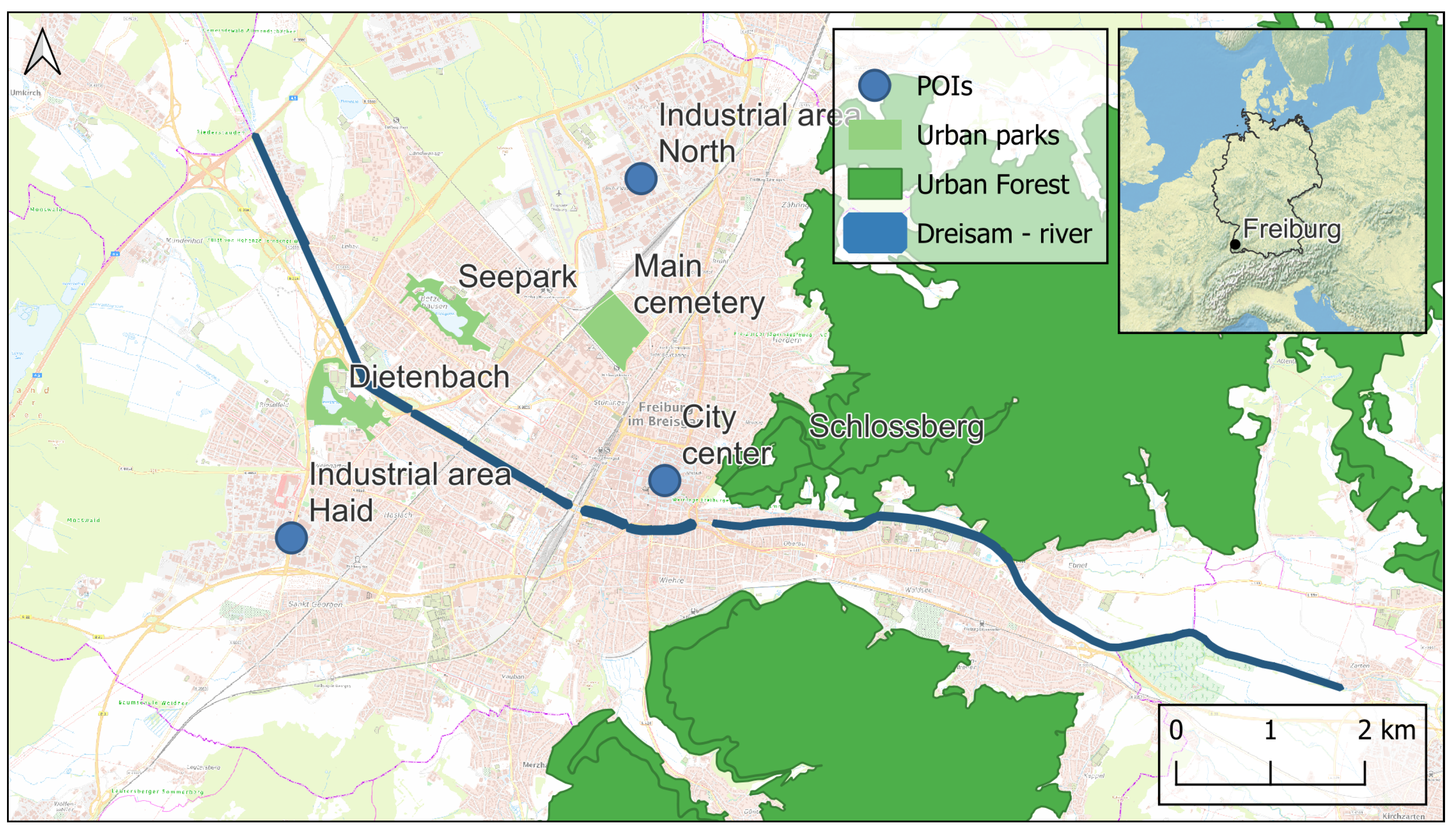

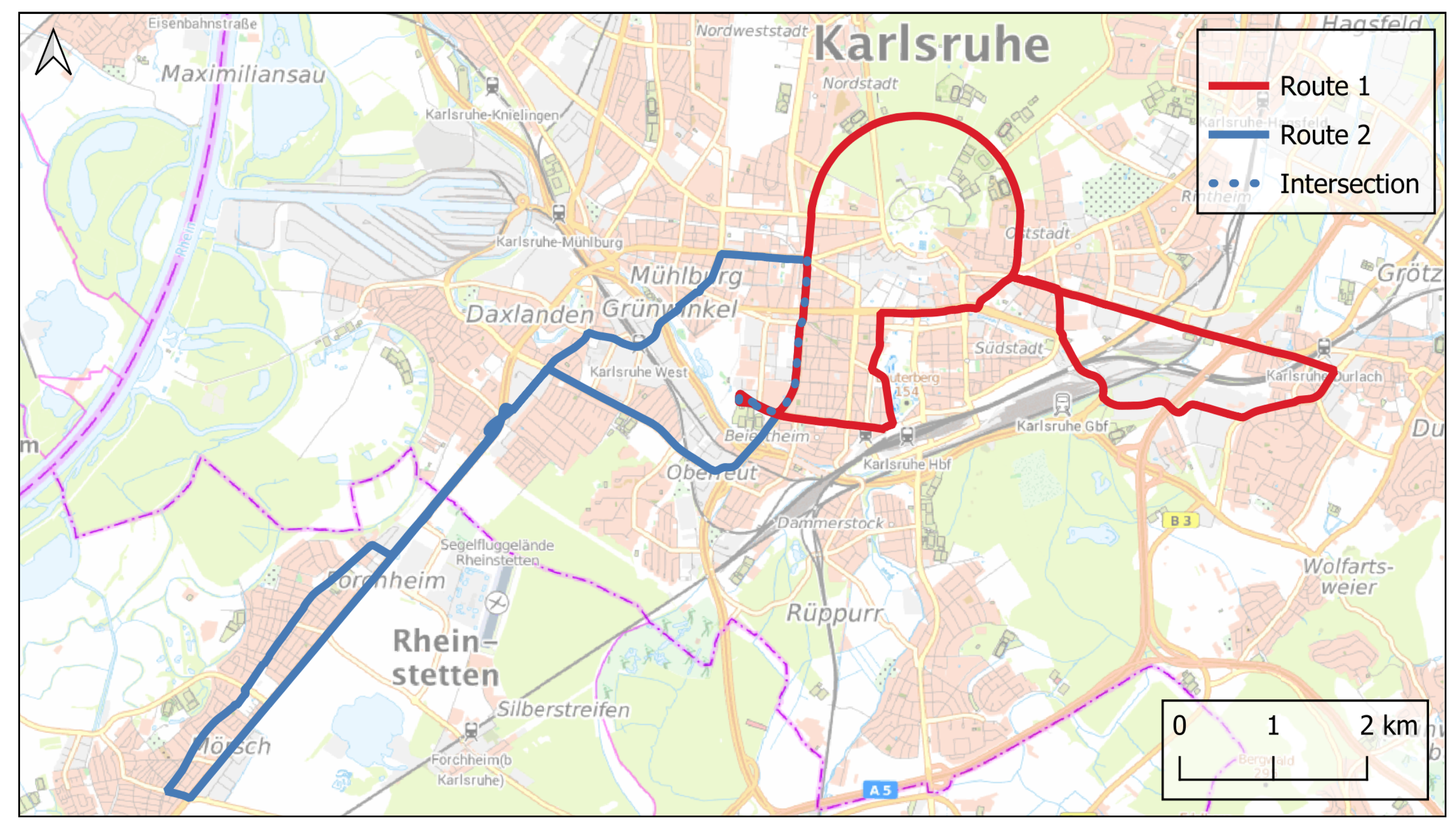
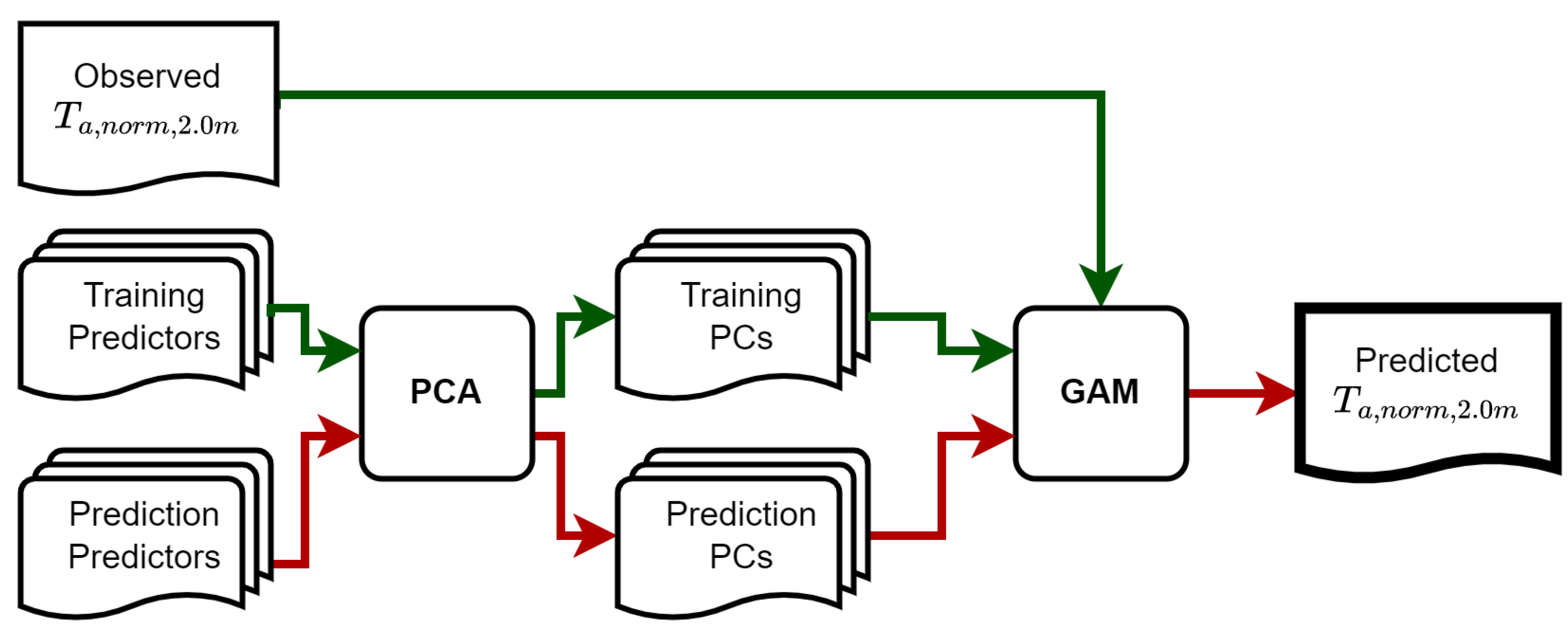
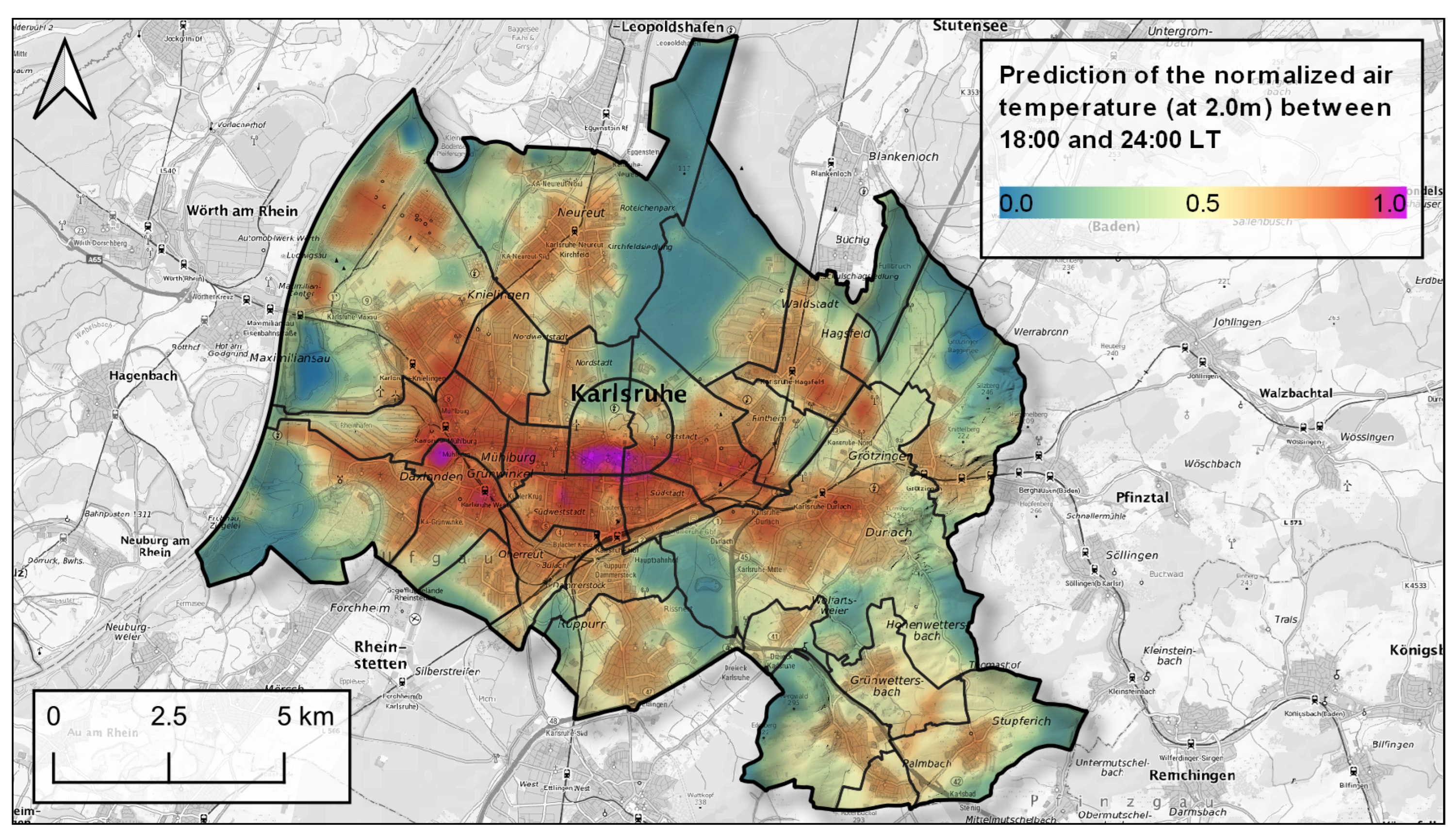
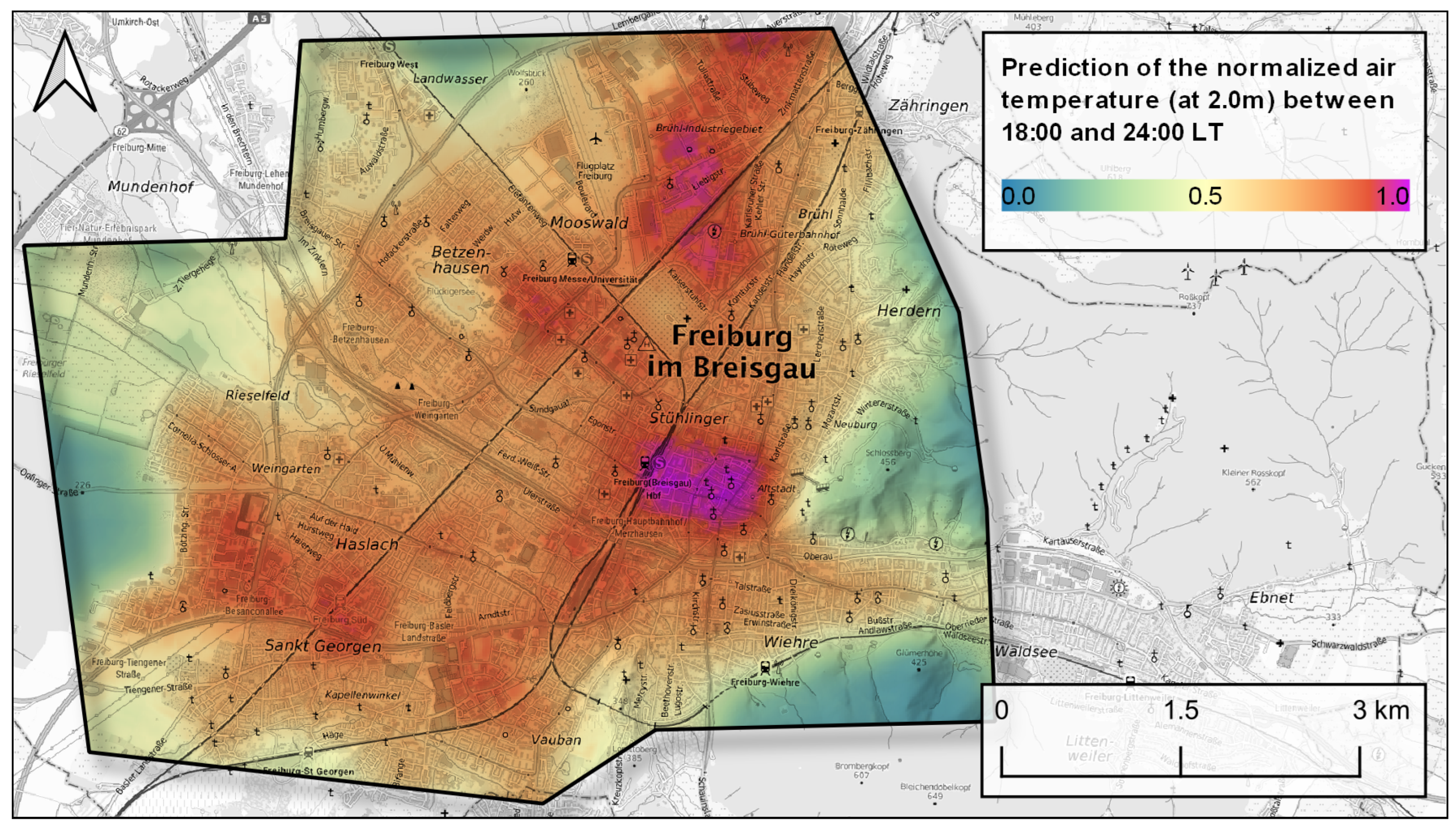

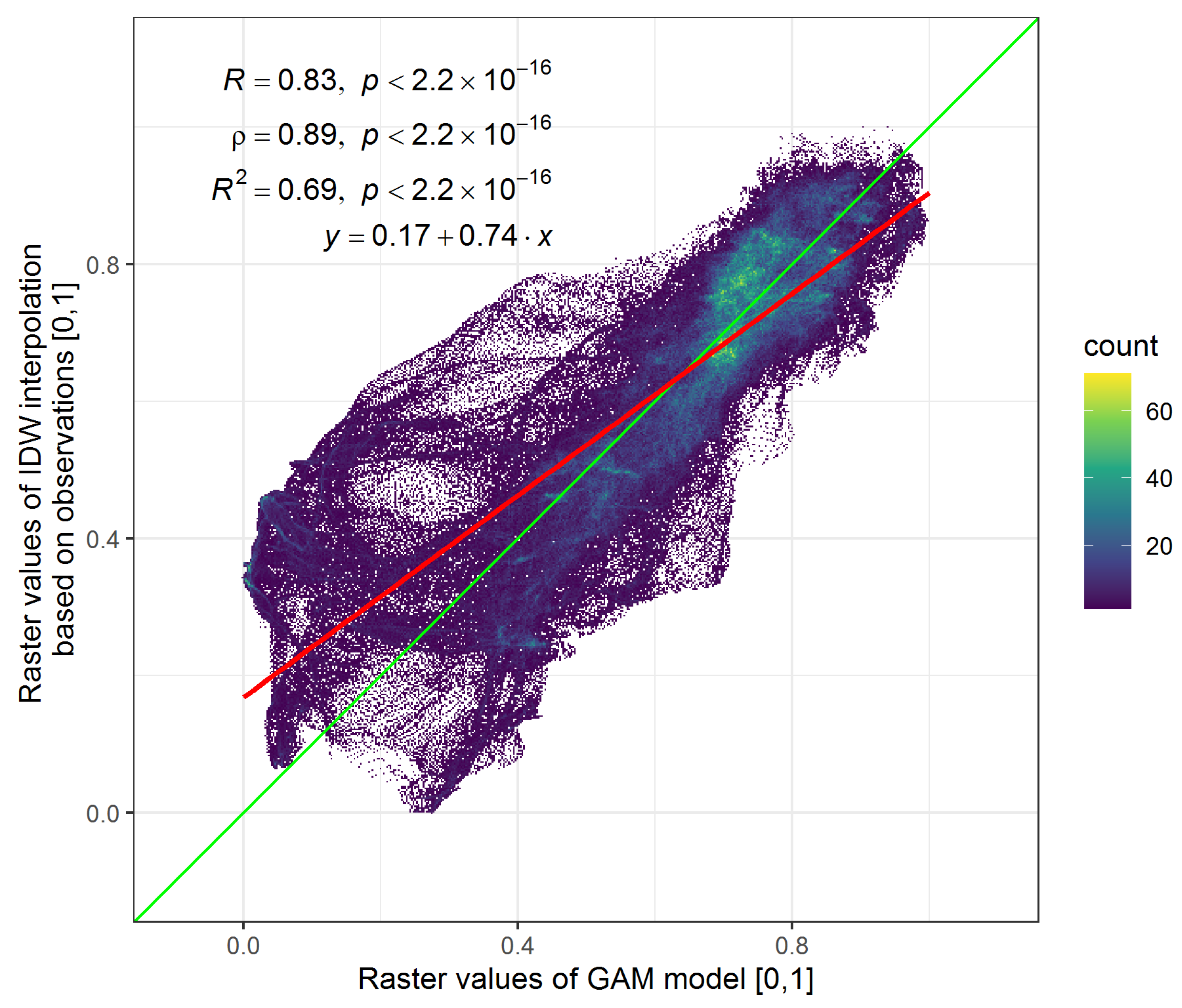
| Time (LT) | Time (UTC) | Min (°C) | Mean (°C) | Max (°C) |
|---|---|---|---|---|
| 0–6 | 22–4 | 13.9 | 18.3 | 22.0 |
| 6–12 | 4–10 | 19.5 | 23.3 | 28.7 |
| 12–18 | 10–16 | 26.3 | 29.4 | 33.1 |
| 18–24 | 16–22 | 18.9 | 25.1 | 29.3 |
| Time (LT) | Time (UTC) | Min (°C) | Mean (°C) | Max (°C) |
|---|---|---|---|---|
| 0–6 | 22–4 | 12.3 | 17.8 | 21.7 |
| 6–12 | 4–10 | 19.4 | 23.7 | 27.6 |
| 12–18 | 10–16 | 26.4 | 28.5 | 31.3 |
| 18–24 | 16–22 | 17.2 | 24.4 | 29.5 |
| Name | Description |
|---|---|
| Buildings_Official_Dens | Density of buildings within
25
and within with a radius of 178 —Buildings are provided by the municipality |
| Buildings_OSM_Dens | Density of buildings within
25
and within with a radius of 178 —Buildings are provided by OpenStreetMap |
| BuildingHeights_Official_Dens | Density of building heights within
25
and within with a radius of 178 |
| Name | Description |
|---|---|
| UA2018_12100_Dens | Density of the industrial, commercial, public, military, and private units within 25 and |
| UA2018_14100_Dens | Density of the urban green space within 25 and |
| UA2018_14200_Dens | Density within 25 and |
| UA2018_21000_Dens | Density of the arable land (annual crop) within 25 and |
| UA2018_31000_Dens | Density of the forests within 25 and |
| UA2018_50000_Dens | Density of water bodies within 25 and |
| UA2018_12210_Dens | Density of fast transit roads and associated land within 25 and |
| UA2018_12230_Dens | Density of railways and associated land within 25 and |
| Name | Description | Resolution |
|---|---|---|
| NDVI_MEDIAN_2020 | Median NDVI derived from Google Earth Engine by [72] based on Landsat 8 data | 15 (pan-sharpened) |
| IMD_2018_010m | IMD by Copernicus program [38] | 10 |
| TCD_2018_010m | TCD by Copernicus program [38] | 10 |
| Time Interval of GAM (LT) | |||
|---|---|---|---|
| 00:00–06:00 | −12,361 | −12,314 | |
| 06:00–12:00 | −6607 | −6564 | |
| 12:00–18:00 | −8013 | −7960 | |
| 18:00–24:00 | −13,380 | −13,355 |
Disclaimer/Publisher’s Note: The statements, opinions and data contained in all publications are solely those of the individual author(s) and contributor(s) and not of MDPI and/or the editor(s). MDPI and/or the editor(s) disclaim responsibility for any injury to people or property resulting from any ideas, methods, instructions or products referred to in the content. |
© 2024 by the authors. Licensee MDPI, Basel, Switzerland. This article is an open access article distributed under the terms and conditions of the Creative Commons Attribution (CC BY) license (https://creativecommons.org/licenses/by/4.0/).
Share and Cite
Gangwisch, M.; Ludwig, S.; Matzarakis, A. Modeling the Normalized Urban Heat Island for the City of Karlsruhe by Linking Urban Morphology and Green Infrastructure. Atmosphere 2024, 15, 125. https://doi.org/10.3390/atmos15010125
Gangwisch M, Ludwig S, Matzarakis A. Modeling the Normalized Urban Heat Island for the City of Karlsruhe by Linking Urban Morphology and Green Infrastructure. Atmosphere. 2024; 15(1):125. https://doi.org/10.3390/atmos15010125
Chicago/Turabian StyleGangwisch, Marcel, Svenja Ludwig, and Andreas Matzarakis. 2024. "Modeling the Normalized Urban Heat Island for the City of Karlsruhe by Linking Urban Morphology and Green Infrastructure" Atmosphere 15, no. 1: 125. https://doi.org/10.3390/atmos15010125
APA StyleGangwisch, M., Ludwig, S., & Matzarakis, A. (2024). Modeling the Normalized Urban Heat Island for the City of Karlsruhe by Linking Urban Morphology and Green Infrastructure. Atmosphere, 15(1), 125. https://doi.org/10.3390/atmos15010125





